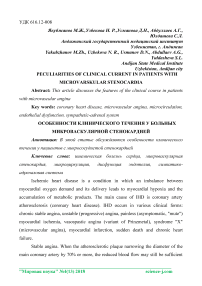Peculiarities of clinical current in patients with microvarskular stenocardia
Автор: Yakubzhanov M.Zh., Uzbekova N.R., Usmanov D.N., Abdullaev A.G., Yuldasheva S.L.
Журнал: Мировая наука @science-j
Рубрика: Основной раздел
Статья в выпуске: 4 (13), 2018 года.
Бесплатный доступ
This article discusses the features of the clinical course in patients with microvascular angina
Coronary heart disease, microvascular angina, microcirculation, endothelial dysfunction, sympathetic-adrenal system
Короткий адрес: https://sciup.org/140263488
IDR: 140263488
Текст научной статьи Peculiarities of clinical current in patients with microvarskular stenocardia
Ischemic heart disease is a condition in which an imbalance between myocardial oxygen demand and its delivery leads to myocardial hypoxia and the accumulation of metabolic products. The main cause of IHD is coronary artery atherosclerosis (coronary heart disease). IHD occurs in various clinical forms: chronic stable angina, unstable (progressive) angina, painless (asymptomatic, "mute") myocardial ischemia, vasospastic angina (variant of Prinzmetal), syndrome "X" (microvascular angina), myocardial infarction, sudden death and chronic heart failure.
Stable angina. When the atherosclerotic plaque narrowing the diameter of the main coronary artery by 70% or more, the reduced blood flow may still be sufficient to ensure low myocardial oxygen demand at rest, but not sufficient to increase this demand under the influence of physical or psychoemotional load. This increases the heart rate, increased blood pressure (BP) and increased myocardial contractility; all these factors increase the need for myocardium in oxygen. One of the factors that can potentially aggravate inadequate oxygen delivery in stable angina is inadequate vasoconstriction due to endothelial dysfunction. Normally, the increase in myocardial oxygen demand during exercise is counterbalanced by an increase in blood flow, as the accumulation of local metabolites causes vasodilation. With dysfunction of the endothelium, vasodilatation is disturbed and a paradoxical narrowing of the vessels is possible. In some patients with stable angina, fluctuations in arterial tone play a minimal role in reducing oxygen delivery to the myocardium, and the level of physical activity that causes angina is almost constant. These patients have "angina with a fixed threshold". In other cases, the degree of dynamic obstruction caused by vasoconstriction or vasospasm plays a more significant role, and this group of patients may have "angina with a variable threshold". For example, there are days when a patient can perform loads without discomfort in the chest, but on other days the same level of oxygen demand in the myocardium causes symptoms - this difference reflects fluctuations in vascular tone in places with a fixed stenosis.
Clinical manifestations of myocardial ischemia. During ischemia, cardiomyocytes switch from aerobic to anaerobic metabolism. Reduced production of ATP disrupts the interaction between contractile proteins and leads to a transient decrease in both systolic contractility and diastolic left ventricular (LV) relaxation. In addition, local accumulation of anaerobic metabolism products (for example, lactate, serotonin, adenosine) occurs. These substances activate the peripheral pain receptors of the C7-Th4 segments in the spinal cord and cause angina pectoris. During the pain syndrome, generalized sympathetic and parasympathetic stimulation can cause tachycardia, sweating, and nausea. Since ischemia leads to disruption of diastolic relaxation of the myocardium, LV rigidity increases and intraventricular diastolic pressure increases. Increased pressure is transmitted to the pulmonary vascular bed and can cause shortness of breath and pulmonary edema. In addition, transient disturbances of ion transport in the cardiomyocyte and local accumulation of metabolites can cause dangerous ventricular arrhythmias. After resolving an acute ischemic episode (that is, after restoring the balance between the delivery of oxygen and the need for it), the symptoms of angina completely disappear, and in the case of short-term ischemia, persistent myocardial damage is absent.
Vasospastic angina pectoris. A number of patients develop episodes of local spasm of the coronary arteries in the absence of obvious atherosclerotic lesions; this syndrome is called "variant" angina or stenocardia of Prinzmetal. In this case, oxygen delivery to the myocardium is reduced due to intense vasospasm, which causes angina pectoris. The mechanism of development of such a pronounced spasm is finally unknown. It is believed that many of these patients have initial atherosclerosis, manifested only by endothelial dysfunction, since in patients with this condition the response to many endothelium-dependent vasodilators (eg, acetylcholine and serotonin) is abnormal. Vasospastic angina often develops at rest, because the cause of ischemia is a pronounced transient reduction in oxygen delivery, rather than the need for myocardium in it.
"Mute" (painless, asymptomatic) ischemia. Episodes of myocardial ischemia sometimes develop in the absence of subjective discomfort or pain (such cases are called "mute ischemia"). These asymptomatic episodes can occur in patients who, in other cases, experience typical symptoms of angina pectoris, but sometimes "mute" ischemia may be the only manifestation of CBC.
"Mute" ischemia can be detected using instrumental methods (ambulatory Holter ECG monitoring or stress test) [2]. Mental ischemic episodes are observed in 40% of patients with stable angina and 2.5-10% of middle-aged men who do not complain. Given the importance of the symptom of angina pectoris, as a physiological alarm signal, the asymptomatic nature of ischemia becomes a negative factor. The reason why some episodes of ischemia are "dumb", and others are accompanied by symptomatology, is not completely clear. The severity of ischemia can not fully explain these differences, since some patients can tolerate even myocardial infarction without symptoms.
Syndrome "X". This term denotes patients with typical symptoms of angina pectoris, which have no signs of significant stenosing coronary artery lesions in coronary angiography. Some of these patients have signs of ischemia when performing a physical exercise test. The pathogenesis of ischemia in this situation can be associated with inadequate vasodilation of resistive coronary arteries. It is believed that resistive vessels (which are too small to be visible in coronary angiography) in such patients may inadequately expand during periods of increasing myocardial oxygen demand. The prognosis of patients with the syndrome "X" is better than in patients with obvious atherosclerotic lesions.
Список литературы Peculiarities of clinical current in patients with microvarskular stenocardia
- Medicus.ru: http://www.medicus.ru/cardiology/specialist/sindrom-razbitogo-serdca-ili-stress-inducirovannaya-kardiomiopatiya-sindrom-tako-cubo-33873.phtml


